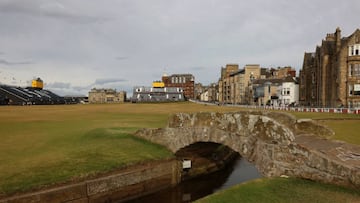The history of St. Andrews Old Course. How old is it? When was the first Open played there?
We are on the eve of the first tee off at The Open from St. Andrews which has been a staple of the golf world for over six centuries. This is its story.

The British Open (strictly known as the Open Championship) tees off from the hallowed St. Andrews Old Course early Thursday morning as the top golfers in the world compete for the Claret Jug. St. Andrews is holy ground in the golf world and it’s called the Old Course for good reason.
Follow the final day of the 150th Open Championship live from St Andrews
St. Andrews is older than the US
For over six centuries, golf has been played on the famous ground we now know as St. Andrews. Widely considered the home of golf, The Old Course is the most historic piece of land in the sport. While it was a game of few in its early origins, it grew to world wide popularity all having stemmed from those early rounds at the Links course.
By the 19th century golf was a way of life in the town of St. Andrews, and many of its habitants were involved in the game. Most played, some were caddies, others made balls and clubs.
The game of golf reaches from north to south, and east to west but in the 15th century, right when the game was taking off, King James II of Scotland banned golf. The King’s reasoning behind it was he felt the sport was taking away from skills young men needed for the good of the country. Skills like archery and other war related practices. So in 1457 golf was prohibited in Scotland and it lasted almost half a century until King James II’s grandson King James IV lifted the ban and took to golf himself.
Long live golf
In the the very early going, the Old Course had a lay out of 22 holes. A front 11, and a back 11. In the 18th century the committee of golfers known last the Society of St. Andrews Golfers deemed some of the holes to be too short. So some holes were combined and the course was cut to 18 holes.
Golf Channel’s newest film, the Open at St Andrews dives into the history of iconic moments at the Old Course through the stories of the greats: Palmer, Nicklaus, Ballesteros, Woods and more.
— Golf Channel (@GolfChannel) July 6, 2022
It all goes down tonight at 8 PM EST on Golf Channel. pic.twitter.com/o6PqGhv8N2
Back in the olden days, the greens were shared, but there was only one cup that would serve for both holes. Normally the singular hole served for a hole on the front half of the course, and the back half of the course. When the course started growing in fame and course congestion began to become a real problem, they started implanting the shared green, but with two different holes. The only way to tell which hole is which is the color of the flag. The front nine holes are marked with a white flag, and the back nine are marked with a red, with the exception of the 18th where a white flag marks the end of the round.
How could you talk about St. Andrews with out talking about it’s vicious, brutal, devious bunkers. The pit bunkers have the capacity to flip an entire Open on its head. Get stuck in one of these hellacious hazards, and you can expect to add some squares to your score card.
Hidden bunkers. Unforgiving hollows. Challenging greens.
— bet365 (@bet365) July 11, 2022
The iconic Old Course at St Andrews, a magnificent test. pic.twitter.com/aK5EyepTGv
This year marks the 30th Open at St. Andrews
There were many adversaries of the Old Course at St. Andrews before it made its name in International golfing folklore. In the late 18th century, Rabbit Farmers were on the verge of taking over the course, until a wealthy landowner named James Cheape saved the day and restored the course.
St. Andrews had the privilege of hosting the first Open Championship in 1873, when Tom Kidd won the title with a two round score of 179. Kidd won £11 (£835 in today’s money, according to the Bank of England, or $998).
Related stories
This year’s edition of the Open will be the 30th played at the Old Course. There have been multiple two time winners at St. Andrews including Tiger Woods, Jack Nicholas, James Braid, Bob Martin and J.H. Taylor. Don’t worry if the last three names don’t ring a bell. They all won the Claret Jug over a hundred years ago.
St. Andrews is one of a kind.
— PGA TOUR (@PGATOUR) July 12, 2022
For @TigerWoods, it was love at first sight 😍 pic.twitter.com/MVbI5sC0RH
For the last centuries St. Andrews has been one of the references of the golf world, and to this day it continues to be not just the site of major championships but also serves as a golfing Mecca for the golf enthusiast. Every year millions visit the small town of St. Andrews to cross the Old Course off their bucket list while trying to go low.

